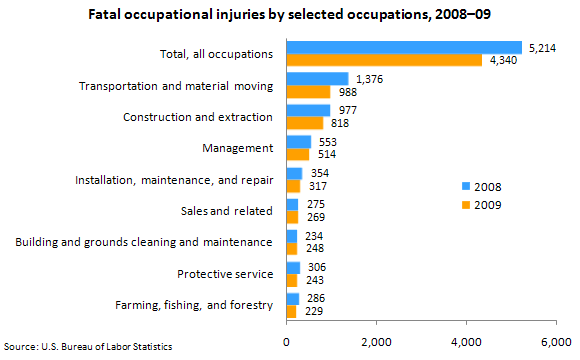The number of fatal work injuries involving workers in transportation and material moving occupations declined by 28 percent in 2009; this occupational group accounted for more than a fifth of all occupational fatalities that year.
Fatal work injuries in construction and extraction occupations decreased by 16 percent in 2009, after declining 17 percent the previous year. Fatal work injuries involving construction laborers, the occupational subgroup accounting for the highest number of fatalities among construction and extraction occupations, declined by 7 percent in 2009.
Fatal work injuries among protective service occupations fell by 21 percent in 2009; fatalities in this occupational group are down 30 percent from a series high reported in 2007. Fewer fatalities among law enforcement workers, fire fighting and prevention workers, and security guards led the decline in this occupational group in 2009.
The building and grounds cleaning and maintenance occupational group was among the few groups with a higher number of fatal injuries in 2009 than in 2008 (up 6 percent), led by an increase in fatal work injuries among grounds maintenance personnel.
This data is from the Census of Fatal Occupational Injuries (CFOI), which is part of the BLS Injuries, Illnesses, and Fatalities program. CFOI compiles a count of all fatal work injuries occurring in the United States during a given calendar year. A preliminary total of 4,340 fatal work injuries was recorded in 2009, down from a final count of 5,214 fatal work injuries the previous year. Counts and rates are likely to increase with the release of final 2009 CFOI results in April 2011. To learn more, see "National Census of Fatal Occupational Injuries in 2009 (Preliminary Results)," (PDF) (HTML) news release USDL 10-1142.





